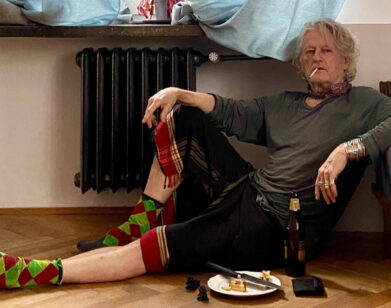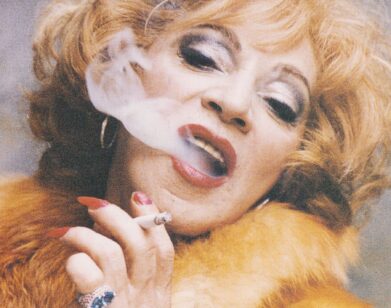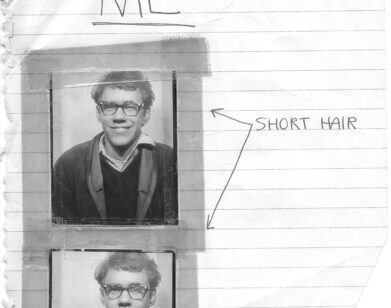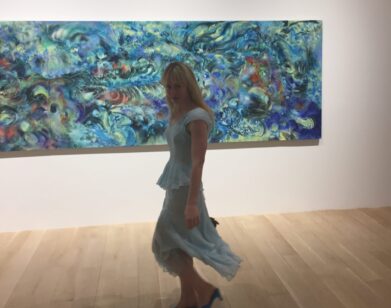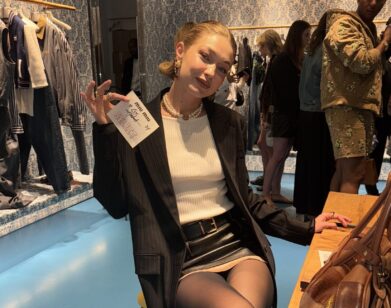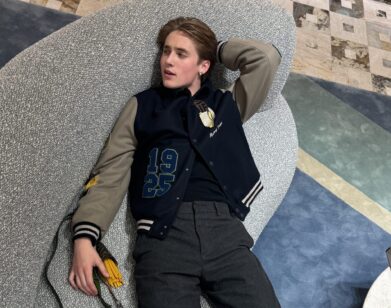WARHOL ABROAD
When East Met West: Christopher Makos and Lee Caplin Reflect on Warhol’s Arrival in China
It’s 1981, and somewhere along the bevelled terrain that stretches between Shanghai and Gansu, Andy Warhol is standing along the Great Wall of China, asking for the nearest escalator. Giggling as he recounts this story on a recent call, the photographer Christopher Makos assures us that the iconic pop artist’s question was entirely serious—in fact, his followup query was, “Where’s the McDonald’s?” For anyone unfamiliar with Warhol’s off-kilter POV, such stories may sound like something out of Lost In Translation. However, those of us well-versed in all things Warhol know that the legendary eccentric was likely inhabiting an entirely different kind of cinematic universe on that trip to China—one that would have been far more entertaining than Sofia Coppola’s 2003 cult classic.
Luckily, footage exists—16 hours of it, to be exact. Four decades ago, Makos and the director-producer Lee Caplin were among a band of glamorous globetrotters who traveled to East Asia with Interview’s founder. The expedition was initially centered around the opening of iClub, a supper club designed by Joseph D’Urso, who installed 50 of Warhol’s Koolaid-colored celebrity portraits at the venue. What actually unfolded, however, has been considered one of the most culturally impactful art visits in history—one that continued to inform Warhol’s work for years to come.
Presented by iStar, MAKOS: WARHOL in China – 40 Years After is a recently unveiled exhibition curated by Caplin and Makos that features the unearthed documentary footage of Warhol’s voyage across Eastern Asia, along with 17 rarely seen silver gelatin photographs captured by Makos. The work, currently on display at the Miami Beach Visual Arts Gallery, will be on view through the week. Below, Caplin and Makos weigh in on what happens when you take one of the most famous 20th century artists—an American obsessed with regimented routine and fast food—out of his element, and thrust him into an oeuvre-altering experience.
———
MAKOS: “None of us knew that we were going to Beijing, we all thought we were going to Hong Kong for the opening of…the iClub. Jeffrey Deitch is the one who organized the trip. He said, ‘Oh, by the way, we’ve organized a real special three-day trip to Beijing.’ We flew from New York to Hong Kong on Pan American, and then after we found out [we were going to Beijing], we went on Air China. There’s a picture of Air China there and it was a Boeing 707, and we were in First Class. In first class you got extra rice, it was so peculiar.”
LEE CAPLIN: “[China] was beginning to be infiltrated by modern American chains. I don’t think McDonald’s was there or Wendy’s, I’m not sure, but Andy talked about it a lot. Coca-Cola certainly was there. I know we were drinking Cokes and Andy said famously, ‘Coke really is the best thing.’ I have him accidentally on camera saying that. It was just beginning to be commercial. It was just the right time for Andy [to visit].”
———
MAKOS: “It was just as China was opening up to the West still, and both Andy and I really loved seeing this uniformity of outfits. Then of course, some of the women were experimenting with Western clothes, so you can imagine it was a mishmash of looks. That simple clean cut of the Chairman Mao suit was very like Yves Saint Laurent, and it was nice to see a sea of people all wearing the same look. It was very fashionable I think.”
CAPLIN: “The interesting thing about the trip is that Andy famously said, “Everybody [in the future] deserves 15 minutes of fame.” And in China nobody knew who he was. It was an extraordinary thing. For him, the only people who recognized him were tourists.”
MAKOS: “When we went to the Great Wall, [Warhol’s] first line was, ‘Where’s the escalator?’ Because the Great Wall is high up, so he was asking about that. Then he said, ‘Where’s the McDonald’s?’ Because at 860 Broadway, one of the very first McDonald’s was over there at the corner of Union Square, and you could be on the third floor of the Factory and look down at McDonald’s and he used to always love to order up stuff directly from McDonald’s.”
———
CAPLIN: “You’ll see in the movie, at some point, Andy wants a piece of art from one of the most famous artists in China at the time. The man presents him with some of his art, and then Andy takes out a marker, and a big sheet of paper, and he draws a dollar sign, and he signed it, of course. He hands it over to the artist as his exchange of art, but also as currency.”
MAKOS: “You have to remember, Halston had a show on the Great Wall, a lot of people were starting to go to Asia at the time, so it was really opening up and they were eager to meet the West and the East was eager to meet us.”
———
CAPLIN: “There we were in China and nobody knew what to do. Nobody knew what [Warhol] was going to say. And we never did get those 15 minutes of fame that Andy predicted. It never came, except from the tourists. And that was extraordinary to find some segment of the globe that hadn’t been touched by pop art and Andy’s pop art, in particular.
———
CAPLIN: “In certain ways, we might as well have been in New York and in China simultaneously, because Andy incorporated his daily life into our experience trooping around China. He began noticing the gigantic graphics on the walls, and verbalized that he wanted to start using big graphics in his art. In fact, he did. He was able to see, appreciate, and incorporate these concepts into something brand new. He took it to the next level, which is what he always did.”
MAKOS: “I was used to [being filmed on the trip]. When you were part of the Factory, there were always cameras around, or somebody being taped, or something being photographed. We were the precursors to what’s going on today. Do you know what I mean? Now they call it ‘selfies.’”
CAPLIN: “[These images were] 50 inches big, they’re silver gelatin prints, and you can feel the texture of the lost art of photography. It’s not digital at all. I actually was standing behind Christopher when he took all these shots, so it really was almost as if the shots came alive, for me. It was a unique experience.”
CAPLIN: [Warhol] embraced what was going on there, made it part of who he is, and brought that back home. I think that was important. I hope this show can tour to China.”
MAKOS: “I haven’t really showed the China pictures all in one grouping like this, so it was a reminder of how quickly time passes. The pictures to me still look contemporary. It seems like just yesterday that all this happened.”
———










